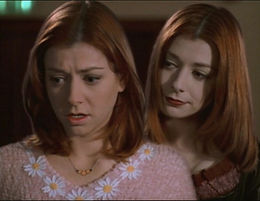
lgtbq studies
Collier, Noelle R., Christine A. Lumadue, and H. Ray Wooten. "Buffy the Vampire Slayer and Xena: Warrior Princess: Reception of the Texts by a Sample of Lesbian Fans and Web Site Users." Journal of Homosexuality 56.5 (2009): 575-609.
Dudley, Rebecca. "Lesbians and Buffy the Vampire Slayer: Popular Culture, the Internet and the Creation of Community" Masters thesis, University of Pennsylvania, Philadelphia, PA, 2001.
Gomez, Lisa. "Buffy Is in Bed with a Woman?: Problematic and Perfect Gay and Lesbian Representation." The Comics of Joss Whedon: Critical Essays. Ed. Valerie Estelle Frankel. Jefferson, NC: McFarland, 2015. 19-30.
Gray, Emily. "Writing 'lesbian, gay-type lovers': Buffy, Postmodern Gothic and Interruptions to the Lesbian Cliché." New Directions in 21st-Century Gothic: The Gothic Compass. Eds. Lorna Piatti-Farnell and Donna L. Brien. New York: Routledge, 2015. 132-145.
Hixson-Vulpe, Jack. "Lesbian Passage: The Representation of the Lesbian from Pulp to Buffy." Subversions: The Journal of Gender and Sexuality 3 (Spring 2007): 23-25. Available online.
Lavigne, Carlen. "Forces of the Universe: Intuition and the Lesbian Witch in Buffy the Vampire Slayer." Technologies of Intuition. Ed. Jennifer Fisher. Toronto: YYZ Books, 2006. 189-199.
Lavoie, Erin. "'Sex, Love and Sadomasochism: Buffy/Spike as a Queer Relationship." Watcher Junior: The Undergraduate Journal of Whedon Studies 6.2 (8), September 2012. Available online.
McAvan, Emily. "'I Think I'm Kinda Gay': Willow Rosenberg and the Absent/Present Bisexual in Buffy the Vampire Slayer." Slayage: The Online International Journal of Buffy Studies 6.4 (24), Summer 2007. Available online.
Mendelsohn, Farah. "Surpassing the Love of Vampires; or Why (and How) a Queer Reading of Buffy/Willow is Denied." Fighting the Forces: What's at Stake in Buffy the Vampire Slayer. Eds. Rhonda V. Wilcox and David Lavery. Lanham, MD: Rowman & Littlefield, 2002. 45-60.
Moorman, Jennifer. "'Kinda Gay': Queer Cult Fandom and Willow's (Bi)Sexuality in Buffy the Vampire Slayer." Supernatural Youth: The Rise of the Teen Hero in Literature and Popular Culture. Ed. Jes Battis. Lanham, MD: Lexington Books, 2011. 102-115.
Pender, Patricia J. "'From Beneath You It Devours': Andrew and the Homoerotics of Evil." Sexual Rhetoric in the Works of Joss Whedon: New Essays, pp. 93-105.
Shuster, Robin. "Reconsidering the Girl-on-Girl: Transgressive Lesbianism on Buffy the Vampire Slayer." Watcher Junior: The Undergraduate Journal of Whedon Studies, vol. 9, no. 1 [13], Spring 2016.
Tropiano, Stephen. "Buffy's Willow Rosenberg." The Prime Time Closet: A History of Gays and Lesbians on TV, Applause, 2002, pp.181-184.
Wilts, Alissa. "Evil, Skanky, and Kinda Gay: Lesbian Images and Issues." Buffy Goes Dark: Essays on the Final Two Seasons of Buffy the Vampire Slayer on Television, edited by Lynne Y. Edwards, Elizabeth L. Rambo and James B. South, McFarland, 2009, pp. 41-56.
___. "Lesbian-Type Lovers: Heterosexual Writer Bias and the Evil/Dead Lesbian Cliché in the Representation of the Willow/Tara Relationship." Paper presented at the Slayage Conference on Buffy the Vampire Slayer, Nashville, TN, 27-30 May 2004. Available online.
FUN FACT: the episode "touched" (7x20) featured the first lesbian sex scene ever aired on network television
"...[T]o associate lesbians and lesbianism with witchcraft still leaves them aligned with unstable, otherworldly powers, and “insinuates that lesbian desire and sexuality are anomalies that exist beyond the normal world, beyond representation on mainstream television and beyond the understanding of most viewers. To relate lesbian sexuality to powers that cannot be understood by general society is to leave room for lesbianism to be interpreted by the Buffy audience as something that is unnatural, unfamiliar, scary, and possibly even evil.
--Alissa Wilts, "Lesbian-Type Lovers: Heterosexual Writer Bias and the Evil/Dead Lesbian Cliché in the Representation of the Willow/Tara Relationship"


